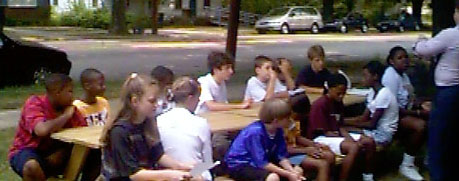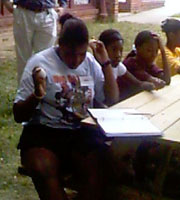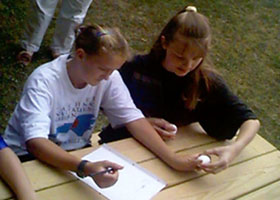|
July 16, 1997
At their halfway point, this session's Explorers are well on their way to a better understanding of the many varied aspects of the Internet. Already they understand the basics of web pages and search engines, and are beginning to move toward mathematical modeling and computational science. The afternoon session began with a brief review of concepts previously learned, and quickly moved into the unexplored area of collaboration tools. Intern Anne Thissen opened this topic, introducing several ways to communicate over the Internet in real time. With an application called Talk, pairs of students traded messages with other pairs. Anne then introduced GlobalChat, chat software that allows an entire group to share a virtual "room" for discussion. She explained that this type of chat was an Internet Relay Chat (IRC)--a realtime discussion on-line. Students enthusiastically experimented with GlobalChat. "Two's a crowd, but three's a party," explained one Explorer, commenting on the advantage of GlobalChat over Talk. Moving on, Anne then introduced CU-SeeMe, chat software supporting video and sound. Using three computers equipped with cameras, students enjoyed watching themselves and their friends onscreen. Anne added that this was a new, imperfect technology, but the benefits of visual realtime chat are numerous: facial expressions and emotions become clear, and the camera can be used to show an event as it occurs in realtime. Shodor employee Danny Grasse introduced the next topic: whiteboard collaboration. With Snowflake Online, Danny illustrated how several "clients" can share and alter information located on a server. Students quickly learned the importance of collaboration and cooperation when using whiteboard applications.
Executive Director Dr. Robert Panoff (Bob1) then began his introduction of computational science with an explanation of the acronym SUCCEED. He explained that computational science is fundamentally a science that is aided by computers used as tools. He stressed the importance of careful observation, and explained the word hypothesis is used "because it sounds fancier" than "educated guess."
An exercise in observation took students outside, where they learned the fallacy of trusted pre-formed conclusions. Using a box of eggs, Dr. Panoff asked the Explorers to observe all they could about each egg, and determine what was inside the shell. Dr. Panoff then proved how "jumping to conclusions" can lead to error by cracking open two of the "eggs." One was filled with grape juice; the other had nothing inside of it. Intern Tom Dietz concluded the session by introducing some of the Shodor Foundation's on-line mathematical models. Starting with a model of population dynamics, Tom demonstrated how such models could be used to quickly predict a trend in a population. Using another model, Tom showed students ways to predict how quickly a flu epidemic spreads through a population. He emphasized that the models were not highly accurate; they depended on assumptions and too few variables to truly model a population. And thus the Internet Explorers left, once again, with a knowledge of the Internet that will take them into the next half of the Club's session.
Last Update: June 14, 1999 Please direct questions and comments about this page to WebMaster@shodor.org © Copyright 1998 The Shodor Education Foundation, Inc. |




